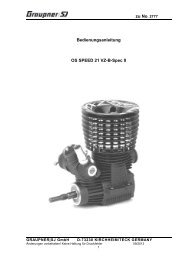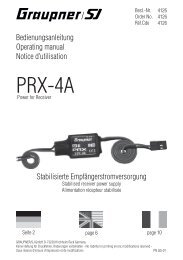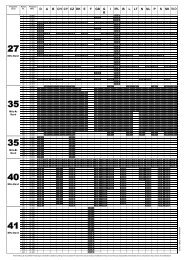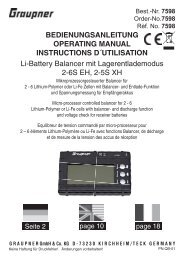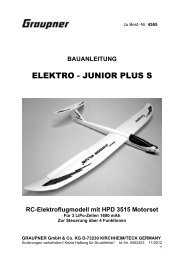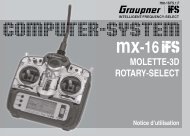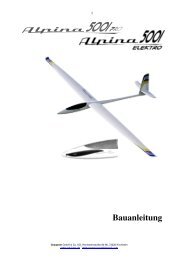Bauanleitung Alpina 4001_ Elektro Graupner_2010_DEF
Bauanleitung Alpina 4001_ Elektro Graupner_2010_DEF
Bauanleitung Alpina 4001_ Elektro Graupner_2010_DEF
You also want an ePaper? Increase the reach of your titles
YUMPU automatically turns print PDFs into web optimized ePapers that Google loves.
22<br />
Note: Be sure to make provision for adequate<br />
air-intake to cool the drive system. Some<br />
customers may prefer to use a so called<br />
Turbo-Spinner which provides for intake of<br />
air through the spinner itself, but do make<br />
sure that adequate cooling is provided.<br />
Only when the motor-mount is fully secure, reinstall<br />
the motor (remember to use lock washers)<br />
and ensure that the drive shaft turns feely and there<br />
is adequate clearances for the propeller yoke and<br />
spinner assembly. A gap of about 1mm between<br />
the spinner and the fuselage nose is recommended.<br />
For the sake of safety, don’t install the propeller<br />
until the model is complete!<br />
Note: Check that the screws used to secure<br />
the motor to the motor mount are not too<br />
long as they may otherwise foul the internal<br />
motor mechanism. You may find it necessary<br />
to countersink the mounting screws slightly,<br />
to achieve clearance with the propeller<br />
yoke/spinner assembly.<br />
Servo mounting tray<br />
The positioning of the components installed in the<br />
nose of the fuselage will depend to some degree on<br />
your choice of motor, speed controller; flight-pack<br />
and receiver battery and all of these will influence<br />
the balance point. Carefully check the physical<br />
layout of all the components, of the electric drive<br />
system bearing in mind the recommended centre<br />
of gravity.<br />
The servo mounting tray is to be located within the<br />
cockpit opening with the trailing edge about 230<br />
mm from the nose.<br />
Note: The servo mounting tray does fit in the<br />
fuselage opening! Turn it around carefully and you<br />
will find that it will slip neatly into place. Don’t be<br />
tempted to apply force, or to remove too much<br />
material which will result in a poor fit.<br />
Mark the position carefully with a pencil. Now<br />
remove the two protective strips from the inside of<br />
the fuselage opening and tack the servo tray in<br />
place using an instant adhesive – before bonding<br />
the frame securely into the fuselage with a<br />
generous bead of thickened epoxy. Allow to cure.<br />
entire servo frame allowing about 10mm extra on<br />
both sides to bond with the fuselage sides.<br />
Fig 4. Servo Mounting Tray / Battery Mount<br />
Installation of the flight battery mount.<br />
The position of the flight battery within the<br />
fuselage will significantly influence the balance<br />
point. Make sure that you can achieve the<br />
recommended centre of gravity with the flight<br />
pack installed.<br />
Start with the front edge of the battery mount<br />
about 100mm from the nose. Fix the battery mount<br />
to the bottom of the fuselage using suitably<br />
thickened epoxy resin.<br />
The flight battery itself is secured using good<br />
quality Velcro tape (Battery Band #YZC.105). Use<br />
one piece of each (hook & loop) under the battery<br />
to secure it fore and aft and other in the form of a<br />
strap to secure it firmly to the battery mount.<br />
Note: Ensure that the flight pack is both<br />
adequately secured and readily accessible for<br />
installation and removal at the flying site.<br />
Fig 5 A, B & C . RC Installation/Motor Mount<br />
Preparing the fuselage push-rods.<br />
Temporarily install the rudder and elevator servos<br />
in the cut-outs in the servo mounting frame<br />
according to the instructions supplied with the<br />
servos. Cut the control linkages to length and<br />
solder clevis adaptors securely to the wire ends<br />
having first thoroughly cleaned and prepared the<br />
joint. Fit clevises and lock-nuts and adjust<br />
accordingly such that the control surfaces are held<br />
at neutral when the servo positions are centred.<br />
Finally secure the Bowden cables to the inside of<br />
the fuselage side using the supplied slotted<br />
hardwood blocks and a little suitably thickened<br />
epoxy to ensure smooth running and slop free<br />
control linkages always keeping mind to minimise<br />
the length of unsupported control linkages.<br />
Wings<br />
Wing Joiner<br />
Tip: Some may wish to complete the job by<br />
adding a layer of wetted fibre glass cloth over the<br />
The wing joiner consists of a single Ø 12 mm<br />
hardened steel joiner which is ample to carry the<br />
flight loads.<br />
<strong>Graupner</strong> GmbH & Co. KG * Henriettenstraße 94-96 * D - 73230 Kirchheim/Teck * www.graupner.de<br />
Stand: <strong>2010</strong>





